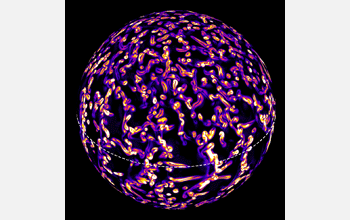Multimedia Gallery
Convection Zone
A computer model developed by researchers at the National Center for Atmospheric Research (NCAR) and other institutions simulates convection patterns in the deep interior of the sun in unprecedented detail. In this image, turbulent areas beneath the solar surface seethe with vorticity. The model simulates spinning columns, sheets and rings of plasma scattered throughout the convection zone.
NCAR is supported by the National Science Foundation (NSF) and other federal agencies to provide facilities and support for a wide range of studies in the atmospheric and related sciences. NCAR is managed by the University Corporation for Atmospheric Research (UCAR), a nonprofit consortium of universities that grants Ph.D.s in fields related to atmospheric science. UCAR's primary function is managing NCAR. To learn more, visit the NCAR website, Here.
Credit: ©University Corporation for Atmospheric Research; Illustration by Mark Miesch
Special Restrictions: This image is owned by UCAR. Before using this image, please read the UCAR Conditions for Use.
Images and other media in the National Science Foundation Multimedia Gallery are available for use in print and electronic material by NSF employees, members of the media, university staff, teachers and the general public. All media in the gallery are intended for personal, educational and nonprofit/non-commercial use only.
Images credited to the National Science Foundation, a federal agency, are in the public domain. The images were created by employees of the United States Government as part of their official duties or prepared by contractors as "works for hire" for NSF. You may freely use NSF-credited images and, at your discretion, credit NSF with a "Courtesy: National Science Foundation" notation.
Additional information about general usage can be found in Conditions.
Also Available:
Download the high-resolution TIF version of the image. (2.9 MB)
Use your mouse to right-click (Mac users may need to Ctrl-click) the link above and choose the option that will save the file or target to your computer.



